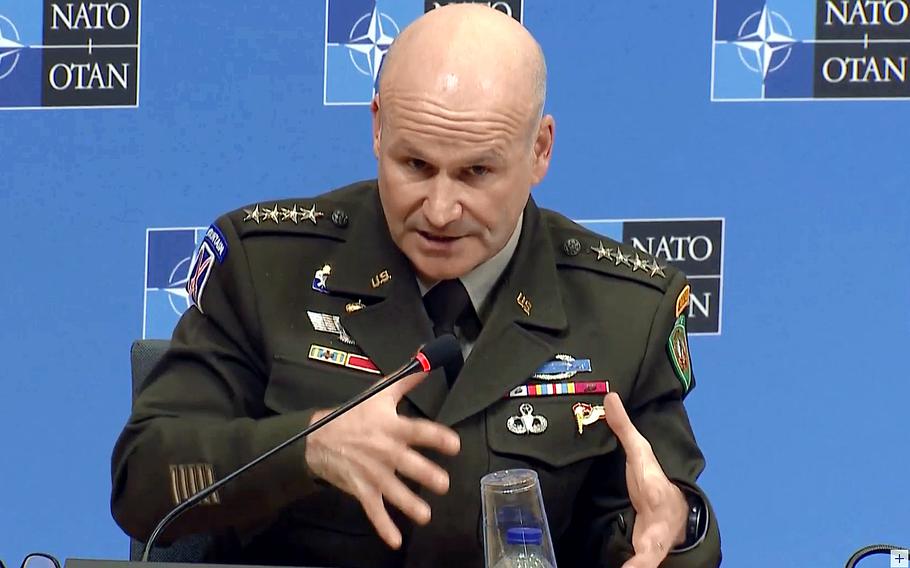
In this screenshot, Army Gen. Christopher Cavoli, commander of U.S. troops in Europe and NATO’s supreme allied commander, talks with reporters on Jan. 19, 2023, following a two-day meeting of allied military leaders at NATO headquarters in Brussels. (NATO)
WASHINGTON — The commander of U.S. troops in Europe expressed confidence Wednesday in an upcoming Ukrainian counteroffensive but said Russia remains a formidable military force that has grown since invading Ukraine last year.
Army Gen. Christopher Cavoli, who also serves as NATO’s top general, offered lawmakers on the House Armed Services Committee a positive appraisal of Ukraine’s readiness to claw back territory occupied by Russian forces while countering it with a sobering look at Russia’s military capabilities.
“Much of the Russian military has not been affected negatively by this conflict,” Cavoli said.
The Kremlin’s ground forces have been “somewhat” degenerated by the war in Ukraine, but its military is bigger today than it was at the start of the invasion and maintains most of its power, he said. Russia’s Navy has lost one ship, and its Air Force has only lost about 80 planes, leaving another 1,000 fighter jets and fighter bombers for battle, Cavoli said.
The Russian air force’s inability to establish air dominance in Ukraine should not be taken as a sign of weakness, cautioned Celeste Wallander, the assistant secretary of defense for international security affairs.
“I think we should not make the mistake of underestimating Russia’s military capabilities because the stakes of getting it wrong are too high,” she said.
Russia continues to flex its military muscle worldwide. In the North Atlantic, for example, Russian submarines have stepped up patrol activities and demonstrated that the country’s undersea forces remain unaffected by the war in Ukraine, Cavoli said.
“I can say that the Russians are more active than we’ve seen them in years, and their patrols into the Atlantic and throughout the Atlantic are at a high level most of the time,” he said. “This is despite all of the efforts that they’re undertaking inside Ukraine.”
Still, Cavoli on Wednesday said Ukraine is well-equipped for an offensive. The U.S. and Ukraine together crafted a list of necessary equipment, and the U.S. has spent the past few months pulling it from allies and its own inventories, he said.
Ukraine now has more than 98% of the combat vehicles that it needs to push into the southern and eastern parts of the country held by Russian forces.
“I am very confident that we have delivered the materiel that they need, and we’ll continue a pipeline to sustain their operations as well,” Cavoli said.
Several House lawmakers argued Wednesday that Ukraine needed more of an edge to break through largely static front lines where Russians troops have become deeply entrenched over the winter.
Rep. Chrissy Houlahan, D-Pa., raised the prospect of sending F-35 jets, a request the White House has repeatedly shot down. Republicans Mike Rogers of Alabama, the chairman of the Armed Services Committee, and Joe Wilson of South Carolina implored defense officials to send Ukraine cluster bombs.
Rogers said the U.S. has more than 3 million of the munitions, which release large numbers of smaller bomblets and are banned in many countries. The Russian military has used cluster weapons in Ukraine hundreds of times, damaging civilian infrastructure and killing civilians, according to the U.N. Human Rights Monitoring Mission.
“Those should be provided [to Ukraine],” Wilson said. “It’s just inconceivable that we don’t do more.”
Cavoli acknowledged the effectiveness of the munition for targeting dense formations of personnel and equipment but said Ukraine’s top need in the near- and mid-term is ground-based air defense. He assured lawmakers that Kyiv was ready to make use of every tool that the U.S. and its allies have provided for the counteroffensive.
“According to the modeling that we’ve very carefully done with them, the Ukrainians are in a good position,” the general said. “They have some weaknesses that I prefer not to talk about in public … but we are confident.”